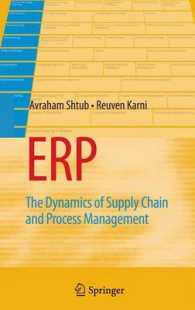- ホーム
- > 洋書
- > 英文書
- > Psychology
基本説明
Tutorial sections at the end of each chapter provide more advanced supplementary material on each individual subject.
Full Description
This clear and balanced introduction to perception examines all the major and minor senses, including vision, hearing, touch, balance, taste, and smell. It provides the reader with a thorough analysis of our perceptual experience, how it relates to the physical properties of the world, and how it is linked to the biological properties of the brain. In addition to covering all material essential to understanding the functioning of the senses, each chapter also includes a 'Tutorials' section. This provides an opportunity for more advanced students to explore supplementary information on recent or controversial developments in subjects such as: the physics and biology of audition; shape and object perception; and mathematics and computational modelling in modern perceptual research. Individual variations in perception are also considered, as are potential sources of difference such as age, sex, expertise and culture. This book will be an invaluable resource for those studying psychology and neuroscience, enabling the reader to achieve a firm grasp of current knowledge concerning the complex processes that underlie our perception of the world."Foundations of Perception" is supported by a tailor-made Student Learning Program and Instructor Resources. The student website includes our Perception Student Learning Program (Perception SLP), which offers a unique and innovative approach to study. The Perception SLP will be available, on a subscription basis, to departments adopting "Foundations of Perception" by George Mather. Each chapter from "Foundations of Perception" is condensed into a concise summary version, providing an effective set of revision notes. These notes also expand on and elucidate the book's content, and cite page number references to the textbook. 'Must know' information is presented in clear accessible style along with sections to stretch more advanced students. The notes also provide an integrative framework for a range of interactive multimedia materials and features, including: animations and simulations of key perceptual phenomena; fill-in-the-blank questions; multiple-choice questions; key-term definitions; research studies; short-essay questions; links to related websites; and Instructor Resources.We offer web-based, password-protected resources free of charge to instructors who recommend "Foundations of Perception" by George Mather. These resources include: a comprehensive chapter-by-chapter slideshow lecture course; and a set of short-answer questions per chapter to stimulate discussion.
Contents
Chapter 1Senses. Methods Used to Study Perception. General Principles of Sensation and Perception. Chapter Summary. Tutorials. Chapter 2: The Chemical Senses. Introduction. Smell. Taste. Flavour. Chapter Summary. Tutorials. Chapter 3: The Body Senses. Introduction. The Somatosensory System. The Vestibular System. Chapter Summary. Tutorials. Chapter 4: The Physics and Biology of Audition. Introduction. Sound as a Physical Stimulus. The Physiology of the Auditory System. Chapter Summary. Tutorials. Chapter 5: Perception of Sound. Intorduction. Loudness Perception. Pitch Perception. Auditory Localisation. Speech Perception. Auditory Scene Analysis. Hearing Dysfunction. Chapter Summary. Tutorials. Chapter 6: The Physics of Vision -- Light and the Eye. Introduction. What is Light? Some Important Properties of Light. The Eye. Chapter Summary. Tutorials. Chapter 7: Visual Physiology. Introduction. The Retina. The Visual Pathway. The Visual Cortex. Chapter Summary. Tutorials. Chapter 8: Spatial Vision. Introduction. Fundamental Functions. Representaion at Multiple Spatial Scales. Uses of Spatial Filters. Chapter Summary. Tutorials. Chapter 9: Shape and Object Perception. Introduction: the Three Stage Model. Shape Representation. Object Representation. Chapter Summary. Tutorials. Chapter 10: Depth Perception. Introduction. The Multiplicity of Depth Cues. Cue Combination. Chapter Summary. Tutorials. Chapter 11: Visual Motion Perception. Introduction. Detecting Movement. The Integration of Motion Detector Responses. Multiple Processes in Motion Perception. Chapter Summary. Tutorials. Chapter 12: Colour Vision. Introduction. Colour Space. Colour Mixture. Dual-process Theory. Colour Interactions. Colour Deficiency. Chapter Summary. Tutorials. Chapter 13: Individual Differences in Perception. Introduction. Age. Sex. Culture. Expertise. Idiosyncratic Individual Differences. Chapter Summary. Tutorials.








